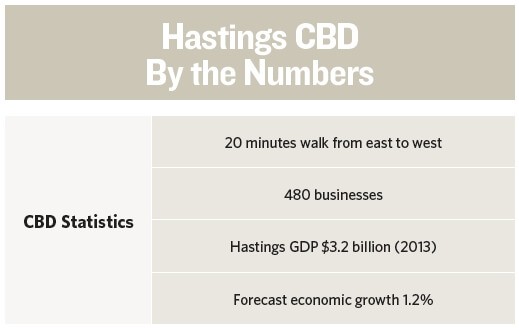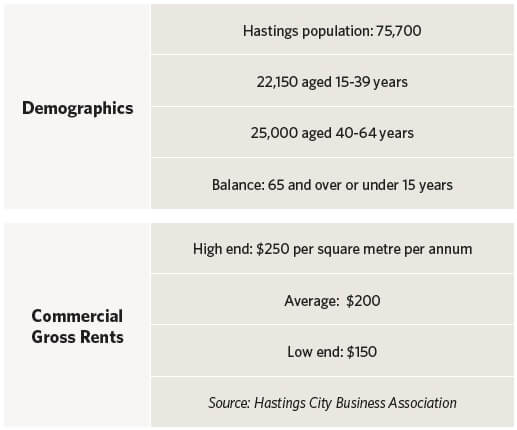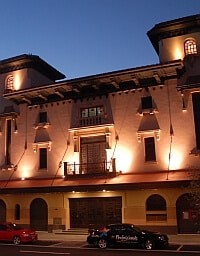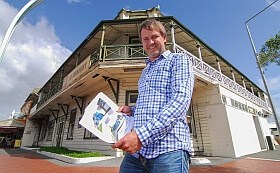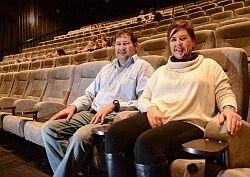Despite ongoing efforts to restore vitality to what aspires to be the heart of Hawke’s Bay, Hastings’ ageing CBD with encroaching ‘for lease’ signs, discount outlets and dozens of at-risk buildings is at the crossroads of viability. Hastings’ image problem is going to take a lot more than cosmetic changes and partisan efforts to fix.
Hastings is a city with a broken heart that desperately needs some love as it trends dangerously toward ‘zombie town’ status, as described by NZ Institute of Economic Research analyst Shamabeel Eaqab in his recent doomsaying tour of the provinces.
The once bustling central city, nostalgically conscious of former glory days when it sprawled out on either side of the railway, now struggles to attract and retain retailers, offices and people, reflecting a region performing near the bottom of the prosperity charts, with a shrinking and ageing population.
Despite the new catch cry ‘Good things grow here” there’s a conviction that Hastings District Council needs to shrink its CBD if it’s to restore vibrancy to the lonely streets it so desperately wants to celebrate.
Louise Thompson of Hastings-based valuers Logan Stone believes Hastings CBD needs to become tighter and more attractive with clustered activity, if it’s to differentiate itself from Napier and get buy in from locals.
The six monthly Logan Stone ‘Retail Occupancy Survey’ to August 2014 showed Napier and Hastings CBD occupancy had dropped to 89.3%, the worst in a decade. The underperformance of Hastings is sending national retail chains straight to Napier, even though the rents are higher.
“We’re normally very conservative when it comes to making predictions, but we’re saying we don’t think things are going to change in Hastings…It needs a strategic approach or it’s going to get worse,” says Thompson.
A quick BayBuzz survey in late September revealed 45 vacancies in Napier, which is currently rethinking its own CBD strategy, and 40 in Hastings, 27 on the west side including larger premises with multiple lease offerings.
Shopping habits have changed drastically. People are increasingly time poor through work and family pressures, preferring to drive to a one-stop outlet or big box retailers rather than traipsing around town.
Online retailing continues to have a big impact with shoppers researching and comparing prices and increasingly purchasing online, which now accounts for just over 6% of this country’s overall retail spend.
Over $1 billion in sales was lost to overseas websites in 2013, and Thompson says most new businesses tend to test their market online before considering CBD tenancies.
Bolder, braver, smaller
Michael Whittaker, local developer and chairman of the Hastings City Business Association, is challenging Hastings District Council (HDC) to make a “quantum shift” in its Central City Plan. “They haven’t made the hard decisions…it’s not bold or brave enough.”
He claims too many grey areas have stifled development and innovation. Building owners and retailers “need to be given the book of what to expect as part of the sell rather than it being a shock when they get here.”
Whittaker says radical change is needed, “a complete rewrite” based on one coordinated vision “not just tweaking around the edges”. A lot of what needs to happen won’t be popular so the council needs “as much support as it does courage.”
If the hard issues aren’t tackled, he warns we’ll end up with even more untenanted and rundown buildings. “Get the vision right, get the town planning and consenting structure right so developers and landowners can make changes to their buildings and the market will take care of itself.”
Hasting mayor Lawrence Yule isn’t convinced. He wants a better understanding of the perceived regulatory constraints and whether or not HDC is “turning people off… I don’t know that’s the case”.
He concedes however that judgements will have be made about what is protected and what’s not. “We may have to give away some things in the interest of change, new development and growth.”
HDC floated its latest Central City Plan back in December 2011. It talked about protecting strengths, unlocking potential for growth and prosperity, pulling together different plans, centralising thinking and coordinating improvement efforts.
More PR words appeared in its vision statement: The CBD needs to be clearly defined as a “multi-faceted heart” acting as a civic centre and gathering place and “… defined by its vibrancy, amenity and liveability, with a clear sense of place and identity as well as resilience to economic and lifestyle trends.”
This year, however, Council only put aside $3.2 million for CBD initiatives including enhancements to Civic Square’s library and art gallery and linking it more tightly with the evolving Heretaunga St East cultural, entertainment and hospitality cluster.
The grand old Opera House, now vacated and deemed an earthquake risk, despite earlier strengthening and modernising, was supposed to be at the hub of this activity.
News that compliance work may cost up to $10m was a real slap on the façade for HDC, particularly as the latest valuation has been more than halved to $6.16 million. Hastings mayor Lawrence Yule insists “we won’t walk away, we will fix it but that might mean we have to change some priorities.”
He hints that HDC’s proposed $5 million incentive for Scenic Hotel Group to build a $19 million, 100-bed inner city hotel to keep conference and event attendees in Hastings may no longer stack up.
Yule is more enthusiastic about the deal with Ngati Kahungunu to integrate its Innovation Centre, including performing arts and tourism opportunities, into the redevelopment of the art gallery and library in Civic Square.
“That will add a significant and powerful cultural dimension and bring the dreams and aspirations of Ngati Kahungunu right into the middle of Hastings.”
Shrinking the CBD
Yule says the business hub of the region, surrounded by productive capacity, needs to be modernised and made more compact and concedes the current CBD plan may not be bold enough.
He says it’s time for a serious look at global trends and what the appropriate mix of retail and commercial might be for Hastings. He’s seeking advice with a view to getting stakeholders together with an independent party to break the problem down into chunks.
“What are the issues, what are the trends in retail and how to migrate to that brave new world incrementally but in a way that is visionary and futureproof.”
Although the council has spent a lot on ancillary work to upgrade the CBD, the next long-term plan (LTP) needs to consider whether it makes sense to continue investing in such things when there are so many empty shops.
He’s not ruling out a ‘big change’ CBD budget, but that has to be balanced with the need to manage a recessionary environment. “People are still struggling and we have to do what we can without putting undue pressure on rate increases.”
Michael Whittaker agrees the central city needs to be trimmed by a couple of blocks to promote density. “You’ve now got the worst of the worst, elongation and width and poor density and you haven’t actually got a CDB.”
Whittaker’s solution? “You pull buildings down … you get rid of them … as part of a collective vision” with new boundaries for a reduced retail precinct. That may require rezoning and “council buying up eight or nine buildings” to put in green spaces or car parks.
He recommends incentives to protect the most attractive and historical buildings along Heretaunga St East and West and its side streets and discouraging retail and office sprawl. “You force them back into the central city.”
That, says Whittaker, means office workers stay in town to shop, have lunch or go for coffee. “Once that capacity’s full, then let it creep out. But let’s give every retailer and every service supporting offices the chance to at least stay in business … to stay alive, and prosper.”
Fork in the road
Susan McDade, manager of the Hastings City Business Association, suggests this is a “transitional phase”, the fork in the road where critical decisions must be made. “Are we going to have high expectations and do some very aspirational things or be reactionary and follow along and just see what happens?”
She also agrees the CBD must shrink, but dealing with different landlords and business owners will require a single strategic vision and strong leadership. Pushing the rents up too high will only attract chain stores and franchises rather than the “mom and pop or boutiques” and start-ups that Hastings needs.
Renovation or wrecking ball – a developer’s dilemma
Changes to the Building Code in the wake of the Christchurch earthquake continue to create aftershocks in Hastings, where the wrecking ball can be more affordable than reinvestment or strengthening work on older buildings.
A cornucopia of consenting challenges and compliance costs face landlords and owners for earthquake strengthening or redeveloping retail or office spaces at a time when rents are low and vacancies are high and there’s little chance of a return on investment.
Hastings Mayor Lawrence Yule says earthquake strengthening and its impact on the occupation and vibrancy of the CBD, and the option that some owners may simply walk away, is a major issue that needs to be worked out at a national level.
“We’ve already done our desktop analysis and we know it effects hundreds of buildings here. We know the ones that need to come back with an engineer’s assessment showing they’re up to standard.”
In his role as chairman of Local Government New Zealand Yule is looking at the options, but says any relief could be around nine months away. One option could be to identify and prioritise risk, with elements such as parapets, verandas strengthened first and the rest over a longer period.
Louise Thompson of Logan Stone confirms the seismic ratings of many buildings in the Hastings CBD, and the fact many aren’t configured for current retail needs, is contributing to the low level of inquiries.
Albert Hotel developer Michael Whittaker says the choice of whether to strengthen, develop or demolish depends a lot on the regulatory, consenting and planning environment, which in many cases involves Heritage New Zealand.
The Historic Places Trust Act covers not only pre-19th century buildings but 1920s and 30s structures, particularly if there’s evidence of some prior activity on the ground. Even pulling a building down or cleaning up a site for future development involves strict compliance.
“It may mean a complete excavation of that site … by a qualified archaeologist and there are a limited supply of those in New Zealand.” Construction and demolition both require costly reports from structural engineers who are in high demand since the Christchurch earthquakes.
While developers may be tempted to simply throw their hands in the air and give up, Whittaker suggests resilience is required. “You just have to get in and solve the problem.”
Susan McDade, manager of the Hastings City Business Association is hopeful of legislation changes to assist with strengthening buildings of community importance.
She says everything possible needs to be done to save facades that are special to Hastings. “If we have a mass exodus of people walking out and just leaving their central city buildings to rot we’ve got a huge problem.”
As part of any grand plan everyone needs to be kept in the loop to ensure collaboration on cost sharing, branding and advertising. “All the components … need to come together … we’re not there yet.”
McDade says those pushing for change need to be tenacious and not take no for an answer. “Passion is infectious. Hastings needs to back itself … it needs vibrancy and the general feeling that people are around and things are happening.”
Logan Stone’s Louise Thompson warns there’s a risk of devaluing property and increasing vacancies by rezoning or saying you don’t want certain types of businesses in some areas.
Inner city living is a key to encouraging density and creating safety and security. It fits well with the cycling culture and having people living and working and doing business in the CBD.
She believes Hastings Council needs to look at zoning issues that might prevent residential growth in the CBD and like other opportunities, if there are “too many hoops” for landlords and retailers to jump through “people give up or their energy gets hand-braked”.
Compliance needs to be streamlined as much as possible, with one go-to person at Council like an account manager to work everything through with the business owner.
Eastern overhaul ahead
Michael Whittaker has purchased many of the worse-for-wear buildings in Heretaunga East including the Little Red Bookshop, Image Trading Centre, the Vivid Shop and the former WINZ centre and is using council incentives to paint some of the fading facades.
With the arguments for saving the rotting 132-year-old Albert Hotel exhausted, he’s still finalising the complexities of Heritage New Zealand’s proscriptive rules for a pre-Christmas demolition.
Once the building and its illegal homeless tenants are removed, he estimates it’ll take nine months for a two-storey complex with several retail and hospitality sites and an open green space to take shape.
Plans are unclear until tenancy and compliance issues are sorted with the colourful and eclectic mix of existing retailers and cafes, faced with anticipating a mix of ancient and modern and hopeful their rents don’t skyrocket.
Whittaker would like to be much further ahead with his own plans, but there are always complications. “We need radical change… a complete step change of attitudes, and we need regulatory support to fix cities like Hastings.”
He believes the state of the CBD is going to get worse before it gets better as more businesses leave, making it even more difficult to find tenants for new builds.
Theatre of engagement
It’s an entertainment poor city that doesn’t have at least one movie theatre. When Reading Cinemas walked away from Heretaunga St East in January 2012 it added to the fears of a mass exodus.
Within 18 months disappointment turned to elation for movie goers. New owners Matt and Julie Bell, having successfully converted aging cinema complexes in Feilding and Levin, made a “significant investment” in Hastings.
They partnered with the owners of the 1933 State Theatre Building who completed seismic strengthening work and a complete interior redesign for their Focal Point Cinema and Café, which re-opened in May with state-of-the-art digital equipment.
Matt Bell says the design of the auditorium was no longer relevant. “35mm film had become obsolete, the audio equipment was clapped out, the screens were old, and a big thing we do is the licensed café so the whole experience can be so much greater.”
The growing number of shop vacancies doesn’t overly concern Bell. “That’s just the changing face of retail that’s happening nationwide. “I don’t see Hastings being any better or any worse than other similar cities and towns.”
He’s aware of clashing views on the future of the CBD. “It’s always hard to get 100% consensus on anything. Sometimes you just have to be entrepreneurial and have the backbone to follow through with your plans and ideas.”
East west divide
You could be forgiven for thinking that all the attention for the Hastings CBD has jumped the rails from west to east, but the westside is still home for the bulk of traditional boutique and chain store retailing, and the business and banking sector.
Mayor Yule is aware that unless the retail mix changes, rents won’t be generated for a sustainable CBD, suggesting there’s currently too much retail on the west side. “We need to bring more people and jobs into the CBD.”
Louise Thompson of Logan Stone believes those in charge of the big picture need to “step outside of the square and be innovative” and ensure both sides of the railway work together.
She doesn’t buy the argument that big box retailers are responsible for fading CBD fortunes. “If the large formats hadn’t been accommodated where they are they would have gone elsewhere and that could have been even worse for the CBD. The fact they are linking to the CBD is really important.”
Susan McDade, of the Hastings City Business Association says some of the smaller operators feel a little left out with all the focus on the big operators. “We don’t need more big box developments.”
She’s wants to focus on helping existing smaller retailers survive by “fixing the environment and improving the experience … by lifting our brand so people want to come here.”
Although effort is going into the externals like upgraded paving, creating outdoor café seating and adding new lighting, she says not enough has gone into improving service, and ensuring shoppers have a range of different experiences.
Notably, some scoffed at the idea of Thursday Night Markets, but persistence paid off. The average attendance over the first 26-week period was 1,500 people between 5.30 to 9pm. Few shopkeepers opened up to support it; one who did recorded the equivalent of a full day’s takings.
The CBD Night Market kicked off again in October and from November HCBA is planning a growers market on Saturday mornings where locals can buy their fruit and vegetables.
Differentiating the CBD
Getting Kiwibank’s call centre into town was a collaborative effort between Council, Business HB, Food HB, EIT, Unison and others who completed due diligence around capacity, staff availability and real estate. That learning curve enabled the development of a resource package to help attract other businesses to Hastings.
Having at least 100 employees operating from the old Farmers building brings people back into the CBD and, according to Yule, other deals are on the boil including a relocation that’ll add 70 jobs. He’s encouraging other large employers in office, education and service industries to move closer.
McDade says she’s seeing greater collaboration during her weekly meetings with seven different council departments and a willingness to look at CBD ideas and listen to feedback from business owners.
She believes Hastings needs to differentiate itself by celebrating its talented, creative, artistic and passionate people. “We need to start selling our stories better and backing Hastings.”
Logan Stone’s Thompson believes the biggest idea killer is fear of change and people who keep harking back to an earlier era when Hastings was allegedly the fastest growing town in the country with a vibrant CBD. “That holds us up … it’s a different world now.”
Mayor Yule says all the Council can do is manage rates, maximise employment opportunities and create demand for space because many of Hastings’ problems are linked to wider global and provincial challenges.
At a time when central government is focusing on Wellington, Auckland and Christchurch, the way forward will require strong leadership from his council and, he says, aggressively searching out employment and business opportunities that support the Hastings economy.
The alternative, says Yule, is more empty shops and the potential for housing values dropping. “Unless we keep up with times … we run the risk of getting some of the effects of zombie towns.”
Sense of safety restored
Until recently the general perception has been Hastings CBD is unsafe even in the daytime. You could experience intimidating language and behaviour, be accosted, bumped off the pavement by an overzealous skateboarder or return to find your car gone.
The arrival of the City Assist ambassadors in October 2013 has dramatically changed that and a commitment of $390,000 from Hastings District Council has ensured they’ll continue patrolling inner city streets for at least another year.
The six ambassadors in their purple teeshirts and brimmed hats have dramatically improved the sense of security for shoppers and retailers. Not only do they settle disputes, liaise with Police and engage positively with those who might appear to be loitering, they help with directions and provide a friendly information service.
What Hastings CBD needs
A bolder collaborative vision
- All parties working together
- Think 21st century, not 1950
- Differentiate from Napier
- Act on the best ideas
- Share resources, reduce the cost
- Improve customer service
Shrink the city sprawl
- At least two blocks too long
- New parks, green spaces
- New car parking areas
- More offices & inner city living
Earthquake strengthening
- Assistance to save key facades
- Encourage re-designs
- Creative use of empty windows
Streamline planning processes
- Make it easier for new businesses
- Council should help not hinder
- Encourage new ideas
Get to grips with global trends
- Make social media social
- More than a shopping experience
- A Hastings CBD web portal
Attract more foot traffic
- Attractive office space
- Lure workers into town
- Encourage cyclists
- Buskers and mini concerts




